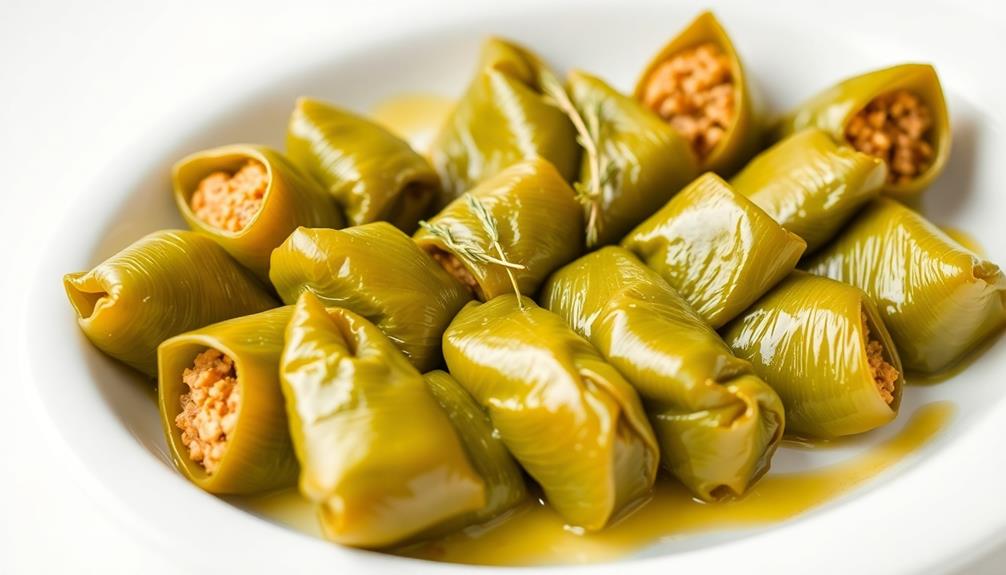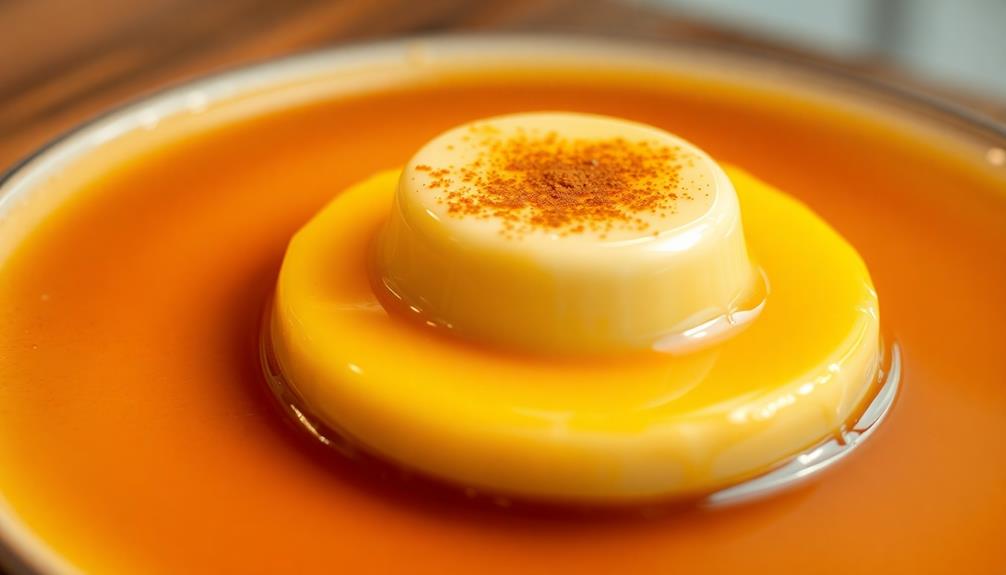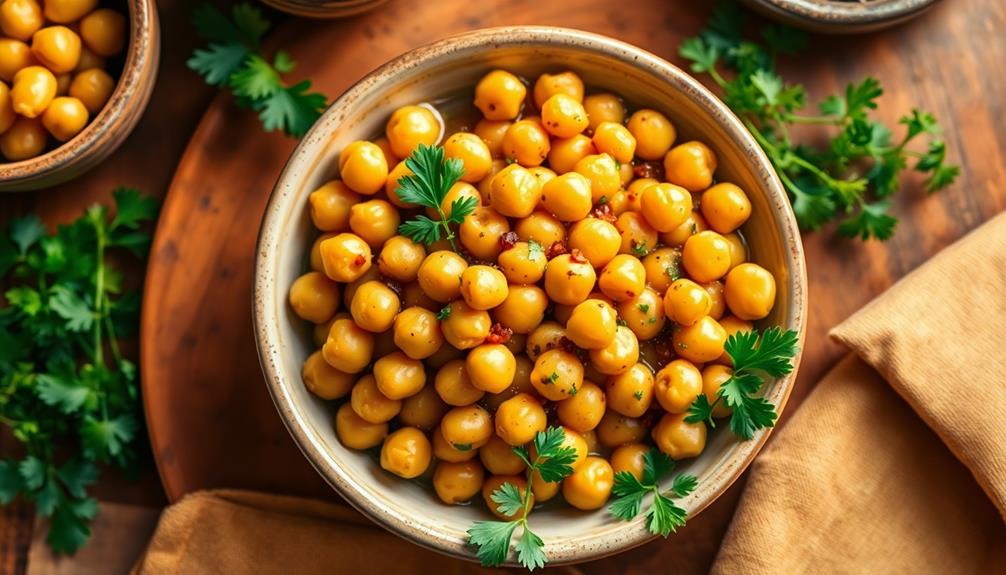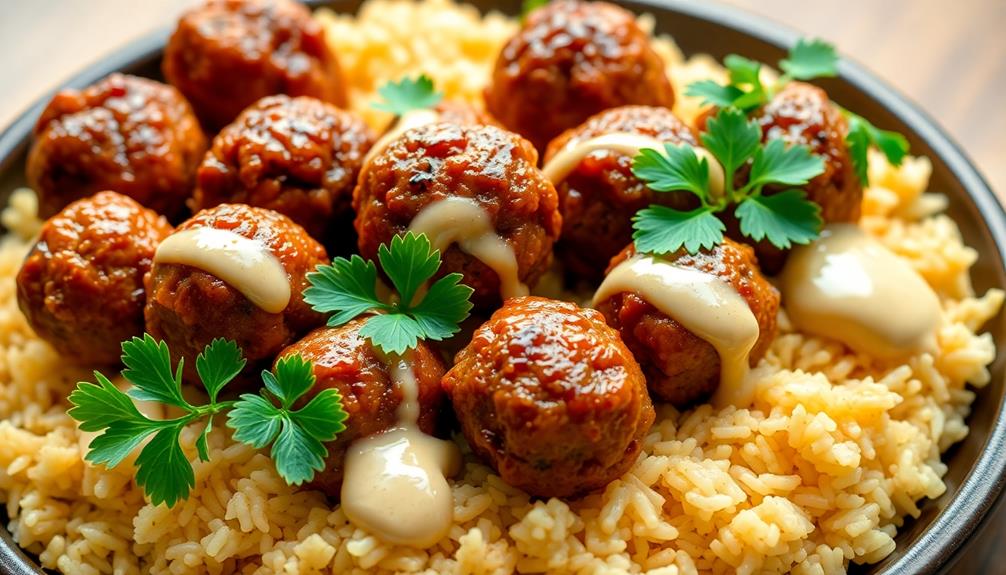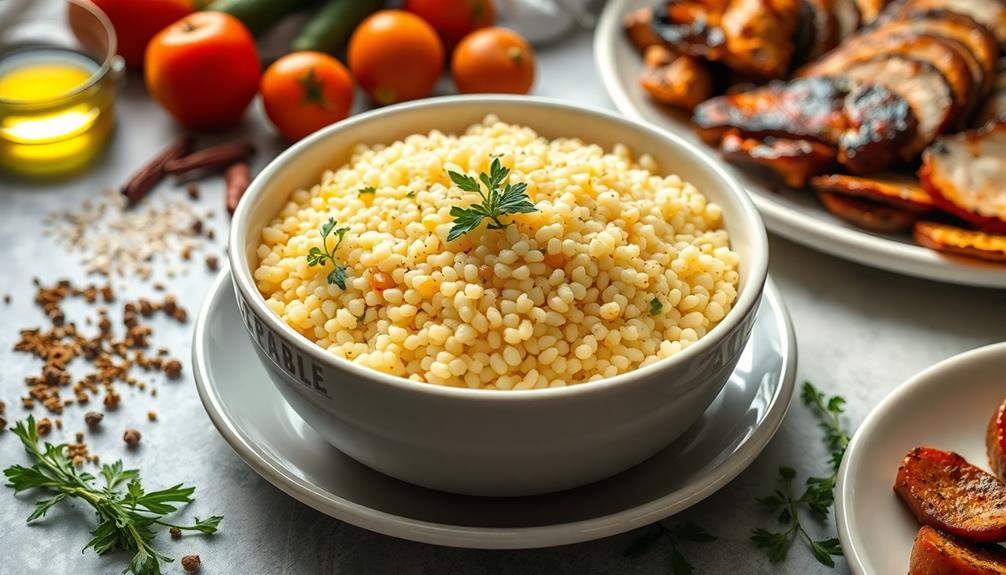Stuffed grape leaves offer a delightful culinary journey that has captivated taste buds for centuries! Originating in ancient Mediterranean civilizations, this time-honored delicacy has evolved with regional variations in fillings. First, you'll rinse the leaves to remove any dirt or bitterness. Next, you'll prepare a savory rice mixture with onions, herbs, and spices. Then, you'll tightly roll the filling into the leaves and arrange them in a pot. After simmering, the tender leaves will meld with the flavorful filling. Serve warm with dipping sauces for an impressive feast. Curious to learn more about the fascinating history and flavors of this beloved dish?
Key Takeaways
- Stuffed grape leaves, known as warak enab, have ancient origins in Mediterranean civilizations and are enjoyed globally with regional variations in fillings.
- Common fillings for stuffed grape leaves include rice, meat, herbs, and spices, with the leaves rinsed, dried, and tightly rolled around the filling.
- The stuffed leaves are arranged in a pot, covered with water or broth, and simmered for approximately 45-60 minutes until tender.
- Preparation involves time and care, but the result is a savory, tangy, and flavorful dish that can be served warm with dipping sauces or accompaniments.
- Stuffed grape leaves can be prepared in large batches and frozen for future enjoyment, making them ideal for family meals or dinner parties.
History
The origins of stuffed grape leaves can be traced back to ancient Mediterranean civilizations, where the dish was a staple in the diets of various cultures. From the Greeks and Romans to the Persians and Arabs, people have been enjoying the savory combination of tender grape leaves and flavorful fillings for centuries.
Over time, the recipe has evolved, with different regions and cultures putting their own unique spin on the classic dish. Some use rice, others opt for meat or a mixture of both. Herbs, spices, and other ingredients are also commonly added to enhance the flavors.
Today, stuffed grape leaves, known as warak enab in the Middle East, are enjoyed around the world. Whether served as an appetizer, a side dish, or a main course, these little parcels of deliciousness continue to delight the palates of food enthusiasts everywhere.
Cooking Steps
Begin by rinsing the grape leaves under cool running water. This will remove any dirt or debris.
Gently pat the leaves dry with a clean towel. Now, it's time to prepare the filling. In a bowl, mix together cooked rice, diced onions, fresh parsley, mint, and a pinch of salt and pepper. Stir until everything is well combined.
Lay a grape leaf shiny-side down on a clean surface. Place a spoonful of the rice mixture near the stem end of the leaf. Fold the sides of the leaf over the filling, then tightly roll up the leaf into a compact cylinder.
Repeat this process with the remaining leaves and filling.
Arrange the stuffed grape leaves, seam-side down, in a large pot. Pour in some water or broth until the leaves are just covered. Bring the pot to a gentle simmer and cook for about 45 minutes, or until the leaves are tender.
Serve warm and enjoy!
Step 1. Rinse Grape Leaves Thoroughly

First, thoroughly rinse the grape leaves under cool running water. This helps remove any dirt, debris, or bitterness that may be lingering on the leaves. Be gentle and take your time – you want to make sure each leaf is thoroughly cleaned.
Next, lay the rinsed leaves out on a clean kitchen towel or paper towels. Gently pat them dry, being careful not to tear the delicate leaves. You want them to be damp, but not dripping wet. This will help the filling stick to the leaves when you start rolling them up.
After rinsing and drying, your grape leaves are ready to be stuffed! Lay a leaf shiny-side down and place a spoonful of the rice and herb mixture near the stem end.
Fold the sides over the filling, then tightly roll up the leaf. Repeat this process until all your leaves are stuffed and rolled.
Now you're ready to simmer the stuffed grape leaves and enjoy this delicious Middle Eastern dish!
Step 2. Prepare Rice Filling Mixture
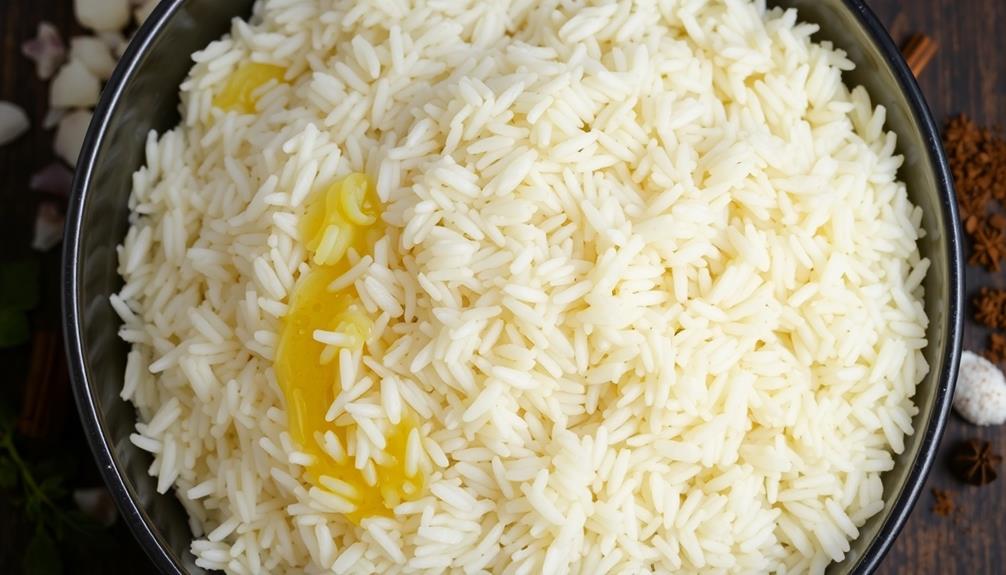
How do you prepare the rice filling mixture? First, you'll need to grab a medium-sized bowl. In the bowl, combine 1 cup of uncooked rice, 1/4 cup of finely chopped onion, 2 tablespoons of chopped fresh parsley, 1 teaspoon of ground cinnamon, 1/2 teaspoon of salt, and 1/4 teaspoon of black pepper.
Mix all these ingredients together until they're well blended.
Next, you'll need to add 1/4 cup of olive oil and 1/2 cup of water to the rice mixture. Stir everything together until the rice is fully coated and the mixture has a nice, moist consistency.
Be careful not to overmix, as you don't want the rice to become too sticky. Once the filling is ready, you can start stuffing the grape leaves.
Remember to taste the mixture and adjust the seasoning to your liking before using it to stuff the leaves.
Step 3. Stuff Grape Leaves Tightly

Once the rice filling mixture is ready, it's time to start stuffing the grape leaves. You'll want to work carefully and tightly pack the leaves.
Gently place a heaping teaspoon of the rice filling onto the center of a grape leaf, shiny side down. Fold the sides of the leaf over the filling, then tightly roll up from the stem end to the tip. Be sure to roll them up snugly, so the filling doesn't come out during cooking.
As you finish each one, place it seam-side down in a deep pot or baking dish. Arrange the stuffed leaves in neat, tight rows, packing them in closely. This helps them hold their shape as they cook.
You'll want to make sure there are no gaps between the leaves, as they'll tend to unravel if they've room to move around. Keep going until you've used up all the filling and grape leaves!
Step 4. Arrange Stuffed Leaves in Pot

With the grape leaves tightly stuffed, it's time to arrange them in the pot for cooking.
Start by laying a few of the largest leaves in the bottom of the pot. This will create a bed for the stuffed rolls and prevent them from sticking.
Next, carefully place the stuffed grape leaves side by side, tightly packed, in rows. Make sure to arrange them snugly, as this will help them hold their shape during the cooking process.
If you have any leftover grape leaves, you can place them on top of the rolls to create a barrier and prevent them from unraveling.
Once all the stuffed rolls are in the pot, pour in enough water or broth to just cover the leaves.
Bring the liquid to a boil, then reduce the heat and let the stuffed grape leaves simmer until they're tender and the filling is cooked through, about 45 minutes to an hour.
Keep an eye on the pot and add more liquid as needed to ensure the leaves stay submerged.
Step 5. Cook Until Tender

Bring the liquid to a boil, then reduce the heat and let the stuffed grape leaves simmer until they're tender and the filling is cooked through, about 45 minutes to an hour.
Keep a close eye on the pot, gently nudging the leaves with a spoon to ensure they cook evenly. The leaves should become soft and pliable, allowing you to easily pierce them with a fork.
Once they're tender, remove the pot from the heat and let the stuffed grape leaves rest for 10-15 minutes. This resting period allows the flavors to meld and the filling to set.
Now you can carefully transfer the cooked grape leaves to a serving platter, spooning some of the cooking liquid over the top to keep them moist.
Serve the stuffed grape leaves warm, alongside your favorite dipping sauces or accompaniments. Enjoy the delicious, aromatic result of your culinary efforts!
Final Thoughts
Although stuffed grape leaves may take some time to prepare, the end result is well worth the effort.
You'll be amazed by the burst of flavors that dance on your tongue – the savory rice and herbs, the tangy lemon, the tender grape leaves. Popping one of these little bundles into your mouth is like taking a trip to the Mediterranean.
Once you've mastered the technique, you can get creative and experiment with different fillings.
Try adding pine nuts, raisins, or even a bit of spicy pepper for a twist. And don't be afraid to make a big batch – these tasty treats freeze beautifully, so you can enjoy them anytime.
Whether you're cooking for your family or hosting a dinner party, stuffed grape leaves are sure to impress.
Frequently Asked Questions
How Long Can Stuffed Grape Leaves Be Stored?
Stuffed grape leaves can actually last quite a while!
When stored properly, they can stay fresh for up to a week in the fridge. Just make sure to keep them in an airtight container or sealed bag.
This way, they won't dry out or pick up any funky smells.
And don't forget to enjoy them within that time – they're so delicious, you won't want to wait too long!
Can I Use Other Types of Leaves Instead of Grape Leaves?
You sure can! While grape leaves are traditional, you can absolutely use other types of leaves in your stuffed delights.
Spinach, kale, or even cabbage leaves work great as tasty alternatives. Just be sure to choose tender, pliable leaves that can hold the filling without tearing. For a delicious and satisfying meal, try using these leafy greens as the wrapping for a flavorful filling. You can easily find a stuffed cabbage rolls recipe online and customize it to your taste preferences. Whether you prefer a vegetarian filling with rice and beans or a meaty filling with ground beef and spices, the options are endless when it comes to stuffed cabbage rolls. Pick out the perfect leaves and get ready to enjoy a nutritious and tasty dish.
Experiment and have fun with different flavors – the possibilities are endless! Get creative in the kitchen and discover your new favorite stuffed leaf recipe.
Is There a Gluten-Free Version of Stuffed Grape Leaves?
Sure, there's definitely a gluten-free version of stuffed grape leaves!
Instead of using regular grape leaves, you can try using collard greens, kale, or even Swiss chard. These alternatives are naturally gluten-free, so you can enjoy the same delicious flavors without any wheat-based ingredients.
The filling can be made with gluten-free rice, veggies, and spices, just like the traditional recipe.
It's a tasty and healthy option for everyone to enjoy!
How Can I Make the Filling More Flavorful?
To make your stuffed filling more flavorful, you can add some exciting ingredients!
Try mixing in aromatic herbs like fresh parsley, mint, or dill. You could also kick up the flavor with a sprinkle of spices like cumin, cinnamon, or allspice.
Don't forget to season with a pinch of salt and pepper too.
With a few simple tweaks, you'll have a stuffed filling that's bursting with delicious taste.
Get ready to impress your friends and family with your culinary skills!
Can I Freeze Cooked Stuffed Grape Leaves?
Yes, you can definitely freeze cooked stuffed grape leaves!
This is a great way to save time and have delicious, home-cooked meals on hand. Simply let the stuffed leaves cool completely, then pack them tightly in airtight containers or freezer bags.
When you're ready to enjoy them, just thaw them in the fridge overnight and reheat in the oven or microwave.
Freezing is a game-changer – you'll always have those tasty, homemade treats ready to go!
